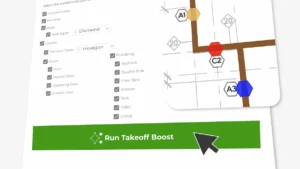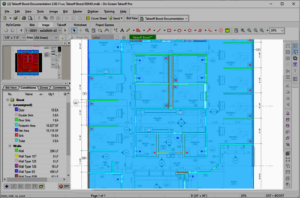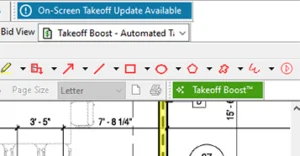When it comes to the concrete and masonry trades, you don’t have to look far to find lots of buzz around green and sustainable construction methods and materials. This includes everything from scientists studying how cigarette butts can conduct energy in bricks and pavement to paint developers rethinking chemicals and colors for more energy-efficient homes.
If you’re a concrete or masonry estimator or project manager, you also know your trade requires very specific know-how and organization. If you’re estimating jobs in the concrete trade, phases of the same job often involve unique quantifications. For example, slab on grade is significantly different from a metal pan takeoff. Estimating for post-tensioned slabs and columns require different quantifications.
In the masonry trade, every aspect is unique. Concrete block or brick? Architectural precast lintels or precast pilasters? Stone or travertine? To increase productivity, reduce waste and increase profits, masons invest in technology and equipment to increase their lay rate and mortar yield.
In today’s highly competitive market, contractors will likely become more eager to embrace tools and materials that could improve productivity and profitability—and lower their carbon footprint.
New Materials Changing Industry
Since the start of 2020, there has been much excitement around a Japanese industrial manufacturer’s claim that they have developed a process to prolong reinforced concrete’s useful life to more than 200 years—twice the length of today’s life cycle.
No doubt, fluctuating construction material costs are fueling some of this interest to think outside-the-concrete box. As a result, more and more general contractors (GCs) are starting to reimagine how these futuristic innovations will redefine how construction projects are conceptualized, designed, and executed.
More than ever, builders and contractors are looking for potential solutions that could lower costs, speed up construction, and improve quality and safety. As such, everything from 3D printing to self-healing concrete is gaining momentum and interest in the construction industry.
Concrete Industry Poised for Disruption
In fact, a 2018 AGC/FMI Risk Study of contractors found that 64% of those surveyed rated “concrete” as the most likely trade to experience peak disruption over the next five years. As such, contractors are beginning to embrace new technology and methods of working—including estimating software, robotics, Augmented Reality/Virtual Reality, wearables, and drones.
It should be noted that building materials represent nearly half the total costs of most projects—or $1 trillion globally, according to the McKinsey Global Institute. They believe newer and better construction materials will have a major impact on how contractors build everything from residential homes to office buildings.
With traditional materials, such as concrete, cement, and asphalt, making up most of this demand, new materials will need to be developed that can lower carbon footprints, improve cost efficiency, and make for a more agile supply chain.
Let’s take a closer look at some of these new building materials and methods and their potential to revolutionize the concrete industry.
3D Printing Saves Time
One of the more exciting developments involves 3D printing.Not only does it reduce time-consuming steps from the design process, but it requires a shorter supply chain and a quicker design process. In fact, a 3D printed home can be completed in just under a day instead of a months-long process. As 3D printers don’t need to eat or sleep, they won’t stop working until a project is finished. This greatly reduces downtime on the jobsite.
In addition, 3D printed buildings have much lower costs than those built with traditional methods because they require less raw material and labor. With additive rather than subtractive processes, less materials are used in 3D printing than in traditional manufacturing processes. Also, labor costs can be reduced by up to 80% by having most construction completed by 3D printers. Production costs are reduced as well by eliminating the need for maintaining large storage spaces and transporting building materials.
Other benefits include that 3D buildings offer more structural integrity. As such, it’s easier to see the finished product before it’s even built. This makes it less complicated to make changes to the building. Also, 3D printing means there are fewer logistical issues during transportation. With 3D printing, materials can be transported cheaply, easily, and safely without requiring post-assembly work or wooden molds.
Self-Healing Concrete Provides Stability
Developed by scientists in the Netherlands, self-healing concrete uses bacteria to close cracks on concrete and is being tested across the United States and Australia. By using chemicals like those found in human bones, infrastructures can “heal” themselves by resealing after a break, in much the same way as human bones fuse together again after a fracture.
Experts predict this technology could be invaluable in earthquake-prone regions where a concrete crack tends to grow and often means the whole structure is unstable.
There is also interest in making cement a more energy-efficient building material. In Mexico, one professor has developed a cement with the capacity to absorb and emit light energy, giving concrete more functionality as well as versatility. This phosphorescent cement can be used to illuminate highways, bike paths, and buildings without the use of electricity. The cement also absorbs solar energy, emitting it during the night for about 12 hours.
Just Add Water to Concrete Cloth
Already in use for building drains, channels, and passages, concrete fused fabric is created when construction workers take a layer of “concrete cloth” and add water, allowing the fabric to set. One advantage is that unlike regular concrete, concrete cloth materials can be installed in the rain and other wet conditions, virtually eliminating rescheduling of work due to weather conditions.
This latest innovation in the concrete and cement market is being used increasingly in the railway infrastructure, mining, civil infrastructure, and petrochemical sectors. Known as concrete canvas and concrete cloth, it has seen increasing use in fast-paced civil works projects.
As the fabric is embedded with concrete and hardens as it is exposed to water, it also forms a waterproof and fireproof shelter. This concept was initially touted for use by the military and in disaster zones to build quick shelters. The concrete fabric can be manipulated into any shape on the ground or slopes and is ready to use within 24 hours.
Precast Concrete Gaining Ground
While cast-in-place may continue to be the preferred choice for concrete slabs and foundations, precast concrete is becoming a strong option because of its quality, affordability, and longevity. Globally, experts predict precast will be worth $138.96 billion by 2022 because of increasing demand for new construction globally due to urbanization and industrialization.
With precast concrete, it is produced by casting concrete in a reusable mold or “form.” It is then cured in a controlled environment, transported to the construction site, and lifted into place. In contrast, standard concrete is poured into site-specific forms and cured on site.
One recent development in the precast concrete field involves precast concrete that cures in 24 hours using carbon dioxide, instead of water. The special binder means the concrete is produced at lower temperatures with a patented curing process.
Experts say this is a big step forward because conventional concrete cured with water takes nearly 30 days to reach its final strength. Also, this new concrete can potentially reduce the carbon footprint of precast concrete by 70%.
Working Smarter with Offsite Solutions
While McKinsey reports that nearly 80 percent of all construction work is still done physically on-site, the construction industry is clearly beginning to embrace off-site solutions that can help improve predictability, consistency, and repeatability.
Given the harsh reality of the current labor shortage and shrinking workspaces in many urban areas, contractors are starting to turn more and more to technology to help them work smarter to ensure productivity and profitability.
While you may not be ready to invest in a 3D printer, you may want to make sure you are using the right takeoff and estimating tools. Request a free trial or demo to see the difference digital tools can make in the concrete and masonry trade.



